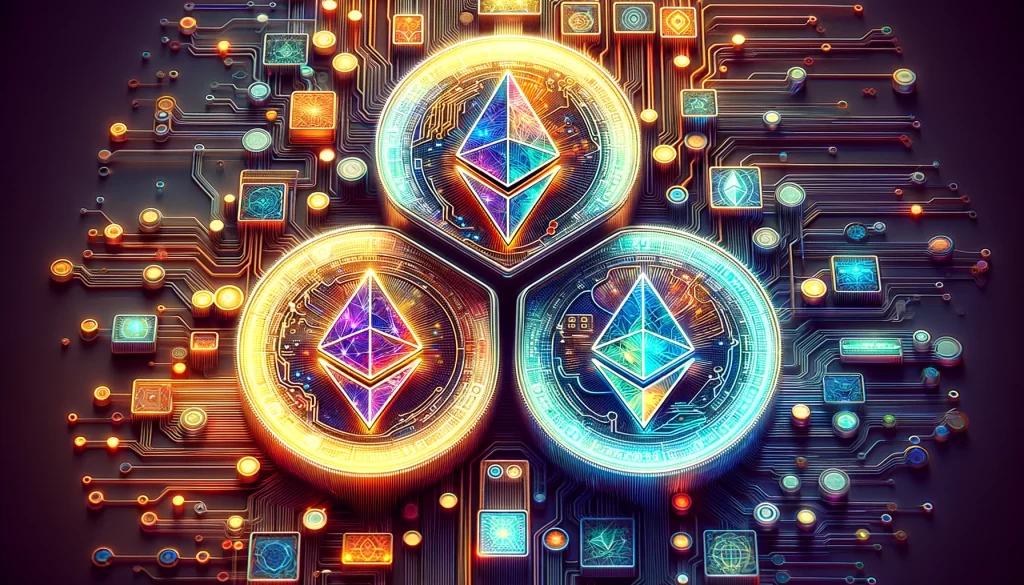Table of Contents
In the dynamic world of blockchain and cryptocurrency, Ethereum Token Standards stand out as a programmable blockchain offering a wide range of functionalities far beyond what Bitcoin introduced.
A crucial aspect of Ethereum’s utility is its ability to support various digital assets represented through different token standards. ERC20, ERC721, and ERC1155 are pivotal in shaping how assets are created, traded, and managed on the Ethereum blockchain.
What is Ethereum?
Ethereum is often described as the foundation for our digital future, offering a platform for decentralized applications, DApps, smart contracts, and various cryptocurrencies.
Its versatility and programmable nature have made it a cornerstone of the decentralized finance (DeFi) movement, enabling users to engage with financial services fully decentralized.
Ethereum Token Standards Explained
Token standards on Ethereum are formal protocols that define the rules for creating and managing tokens on the blockchain. They ensure consistency, interoperability, and compliance with the broader Ethereum ecosystem. The Ethereum community uses Ethereum Request for Comment (ERC) and Ethereum Improvement Proposals (EIP) to introduce and refine these standards.
ERC20: The Fungible Token Standard
ERC20 is the most widely adopted standard for creating fungible tokens, which have the same value and properties as every other token of the same type.
This standard has facilitated the creation of numerous cryptocurrencies and utility tokens, making it a fundamental building block for many projects and applications within the Ethereum ecosystem. ERC20 tokens are divisible, interchangeable, and widely supported across exchanges and wallets.
ERC721: The Non-Fungible Token Standard
ERC721 introduced the concept of non-fungible tokens (NFTs), representing unique, indivisible assets on the blockchain.
Each ERC721 token has a unique identifier, making it perfect for representing ownership of digital collectibles, art, and other one-of-a-kind assets. This standard has fueled the explosive growth of the NFT market by enabling true digital ownership and scarcity.
ERC1155: The Multi-Token Standard
Developed to address the limitations of ERC20 and ERC721, ERC1155 allows the creation of fungible and non-fungible tokens within a single contract.
This innovative standard simultaneously supports the efficient transfer of multiple token types, significantly reducing transaction costs (gas fees) and complexity. ERC1155 is especially beneficial for applications requiring a diverse range of token types, such as gaming and digital collectibles, offering enhanced flexibility, efficiency, and security.
As the Ethereum blockchain continues to mature, the development and utilization of ERC20, ERC721, and ERC1155 token standards have significantly impacted the digital asset landscape. These standards not only facilitate a wide variety of applications within the Ethereum ecosystem but also push the boundaries of what’s possible in terms of tokenization and ownership of digital and real-world assets.
It is also worth mentioning ERC404, an experimental and unofficial Ethereum token standard, which blends the versatility of fungible tokens (ERC-20) and the uniqueness of non-fungible token NFTs.
Advancements and Innovations
The evolution of these standards has led to notable advancements and innovations across multiple sectors, including gaming, art, finance, and real estate. For instance, the gaming industry has leveraged ERC1155 to create complex in-game economies where players can own, trade, and utilize a diverse array of items.
Choosing the Right Ethereum Token Standards
The choice between Ethereum ERC20, ERC721, and ERC1155 depends on the specific needs of a project.
ERC20 is ideal for creating interchangeable tokens like cryptocurrencies or utility tokens. ERC721 is suited for unique digital assets and collectibles requiring distinct identification. ERC1155 offers the best of both worlds, allowing for a mix of fungible and non-fungible tokens, making it particularly useful for complex applications with diverse asset types.
Each Ethereum token standard plays a crucial role in the ecosystem, providing developers with the tools to innovate and create a wide array of decentralized applications.
As the blockchain space continues to evolve, the flexibility and functionality offered by these standards will remain at the heart of Ethereum’s success in enabling a decentralized digital economy.

